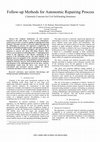Papers by Pattanathu Rahman

—The technical maintenance of civil concrete structures is not really cheap. A way to reduce main... more —The technical maintenance of civil concrete structures is not really cheap. A way to reduce maintenance-related costs is to have a concrete capable of repairing itself when damaged. This paper presents a cybernetic engineering approach for self-healing in concrete. The approach is inspired by the biological self-healing principle to make self-repairing possible in concrete. It consists of adding biological and chemical agents (bacteria) to concrete mix along with Shape Memory Alloys (SMA) to get an improved self-healing effect. A challenging issues related to this approach is that effective monitoring of the progress of the self-healing process. The main challenge is the diagnosis and even prognosis of the cybernetic concrete health. This paper proposes different testing methods to monitor the self-healing in cybernetic concrete. These methods allow for diagnosis and prognosis of the self-healing process in the above concrete. Experimental results from the above tests carried out in conventional and cybernetic concrete samples are shown. Conclusions and future work are also presented.

Quorum sensing (QS) has received significant attention in the past few decades. QS describes popu... more Quorum sensing (QS) has received significant attention in the past few decades. QS describes population density dependent cell to cell communication in bacteria using diffusible signal molecules. These signal molecules produced by bacterial cells, regulate various physiological processes important for social behavior and pathogenesis. One such process regulated by quorum sensing molecules is the production of a biosurfactant, rhamnolipid. Rhamnolipids are important microbially derived surface active agents produced by Pseudomonas spp. under the control of two interrelated quorum sensing systems; namely las and rhl. Rhamnolipids possess antibacterial, antifungal and antiviral properties. They are important in motility, cell to cell interactions, cellular differentiation and formation of water channels that 07-Rahman.indd 1 15/04/2010 19:43:32 2 D.H. Dusane et al. are characteristics of Pseudomonas biofilms. Rhamnolipids have biotechnological applications in the uptake of hydrophobic substrates, bioremediation of contaminated soils and polluted waters. Rhamnolipid biosurfactants are biodegradable as compared to chemical surfactants and hence are more preferred in environmental applications.

In this study, the mixture of mono-and dirhamnolipids produced by Pseudomonas aeruginosa DS10-129... more In this study, the mixture of mono-and dirhamnolipids produced by Pseudomonas aeruginosa DS10-129 was characterized for its toxicity and modulatory effects on Cd availability to different bacteria. Gramnegative naturally bioluminescent Vibrio fischeri and recombinant bioluminescent Pseudomonas fluorescens, P. aeruginosa, Escherichia coli, and Gram-positive Bacillus subtilis were used as model organisms. Rhamnolipids reduced the bioluminescence of these bacteria in less than a second of exposure even in relatively low concentrations (30-min EC 50 45-167 mg l −1 ). Toxicity of Cd to Gramnegative bacteria (30-min EC 50 values 0.16 mg l −1 for E. coli, 0.96 mg l −1 for P. fluorescens, and 4.4 mg l −1 for V. fischeri) was remarkably (up to 10-fold) reduced in the presence of 50 mg l −1 rhamnolipids. Interestingly, the toxicity of Cd to Gram-positive B. subtilis (30-min EC 50 value 0.49 mg l −1 ) was not affected by rhamnolipids. Rhamnolipids had an effect on desorption of Cd from soil: 40 mg l −1 rhamnolipids increased the water-extracted fraction of Cd twice compared with untreated control. However, this additionally desorbed fraction of Cd remained bound with rhamnolipids and was not available to bacteria. Hence, in carefully chosen concentrations (still effectively complexing heavy metals but not yet toxic to soil bacteria), rhamnolipids could be applied in remediation of polluted areas.
Microbial ecology, Jan 1, 2010
Poster presented at UK …, Jan 1, 2009
Metals and Materials …, Jan 1, 2009
Page 1. Met. Mater. Int., Vol. 15, No. 3 (2009), pp. 409~419 doi: 10.1007/s12540-009-0409-9 Publi... more Page 1. Met. Mater. Int., Vol. 15, No. 3 (2009), pp. 409~419 doi: 10.1007/s12540-009-0409-9 Published 26 June 2009 Impact of Ammonia Producing Bacillus sp. on Corrosion of Cupronickel alloy 90:10 S. Maruthamuthu 1,3,* , P ...
Biotechnology letters, Jan 1, 2009
Applied microbiology …, Jan 1, 2010
Biotechnology and applied …, Jan 1, 2010
Books by Pattanathu Rahman









Uploads
Papers by Pattanathu Rahman
Books by Pattanathu Rahman